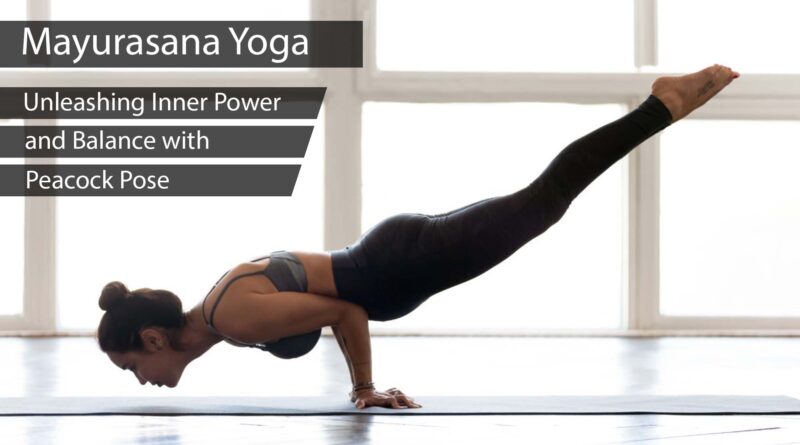Mayurasana Yoga: Unleashing Inner Power and Balance with Peacock Pose
Table of Contents
Introduction
Mayurasana Yoga, or Peacock Pose, is a captivating and challenging yoga posture that embodies inner strength, balance, and resilience. Derived from the Sanskrit words “mayura” (meaning peacock) and “asana” (meaning pose), Mayurasana reflects the majestic and vibrant qualities of a peacock, symbolizing confidence, transformation, and the ability to overcome obstacles.
In this article, we will explore the steps, benefits, variations, and precautions associated with Mayurasana, empowering you to incorporate this empowering pose into your yoga practice.
How to Perform Mayurasana Yoga
To practice Mayurasana Yoga, follow these step-by-step instructions:
Step 1: Start by kneeling on your mat with your knees hip-width apart.
Step 2: Place your palms on the mat, fingers pointing toward your body, and spread them wide.
Step 3: Lean forward, placing your elbows on your abdomen just above your navel, and bring your hands together, forming a fist.
Step 4: Extend your legs straight back, keeping them close together.
Step 5: Press your palms firmly into the mat, engaging your core, and lift your feet off the ground.
Step 6: Maintain a straight line from your head to your heels, with your gaze slightly forward.
Step 7: Hold the pose for 10-15 seconds, gradually increasing the duration as you build strength and stability.
Step 8: To release the pose, gently lower your feet to the ground, come back to a kneeling position, and rest in Child’s Pose.
Benefits of Mayurasana Yoga
Regular practice of Mayurasana Yoga offers a multitude of physical and mental benefits, including:
a. Core Strength and Stability: Peacock Pose activates the core muscles, including the abdominals and lower back, promoting strength and stability in the torso.
b. Improved Digestion and Detoxification: The pressure exerted on the abdomen during Mayurasana stimulates the digestive organs, aiding in digestion, and supporting the body’s natural detoxification processes.
c. Toned Arms and Shoulders: The weight-bearing nature of the pose strengthens the arms, wrists, and shoulders, enhancing upper body strength and toning these areas.
d. Increased Mental Focus and Concentration: Balancing in Mayurasana requires focus and concentration, helping to calm the mind, improve mental clarity, and enhance overall mindfulness.
e. Improved Circulation and Energy Flow: The compression and release of the abdominal area in this pose enhance blood circulation and energy flow throughout the body, promoting vitality and rejuvenation.
f. Boosted Confidence and Inner Power: As you successfully balance in Peacock Pose, it cultivates a sense of confidence, empowerment, and resilience, both on and off the mat.

Variations and Modifications of Mayurasana Yoga
Explore these variations of Mayurasana to add variety and accommodate different levels of practice:
a. Half Mayurasana Yoga: Instead of fully extending your legs, keep your knees bent and lift one foot off the ground at a time. This modification allows for a gradual progression toward the full expression of the pose.
b. Forearm Mayurasana Yoga: Instead of placing your palms on the mat, balance on your forearms, with your elbows directly below your shoulders. This variation provides additional stability and support for those with wrist discomfort or limitations.
c. Wall-assisted Mayurasana Yoga: Place your feet against a wall for added support and stability. This variation helps build confidence and allows you to focus on the alignment and engagement of your core muscles.
Precautions and Contraindications
While Mayurasana Yoga can be a powerful pose, it’s important to consider the following precautions:
a. Avoid practicing Mayurasana if you have recent or chronic wrist, elbow, or shoulder injuries. If you have any concerns or limitations, consult with a healthcare professional or an experienced yoga instructor before attempting this pose.
b. Pregnant women and individuals with high blood pressure or hernias should avoid practicing Peacock Pose.
c. Always warm up the wrists, shoulders, and core before attempting Mayurasana to minimize the risk of strain or injury.
Conclusion
Mayurasana Yoga, the Peacock Pose, invites you to tap into your inner power, balance, and resilience through the practice of yoga. As you embody the strength and beauty of a peacock, Mayurasana offers numerous physical and mental benefits, including core strength, improved digestion, increased focus, and boosted confidence.
Approach Mayurasana with patience and persistence, respecting your body’s limits, and honoring your own unique journey. Embrace the transformative power of Peacock Pose and incorporate it into your yoga practice, allowing it to unlock your inner strength, grace, and unwavering spirit.





